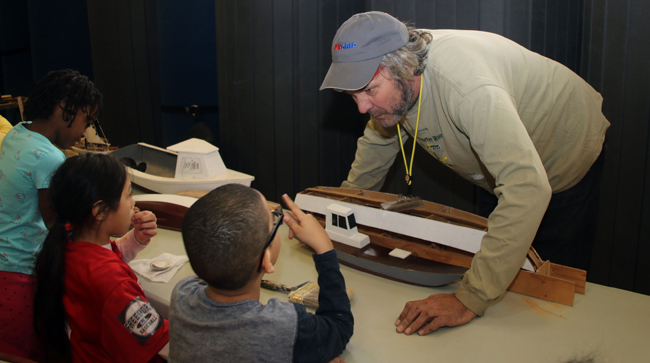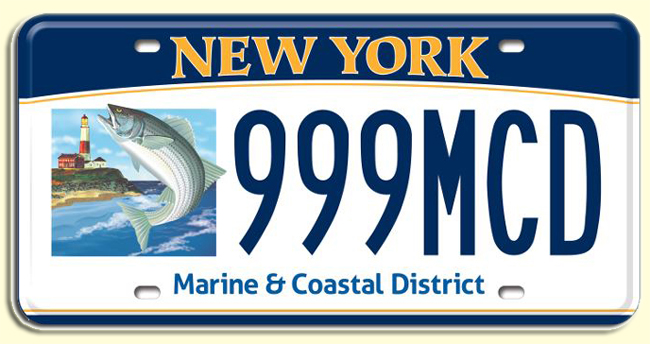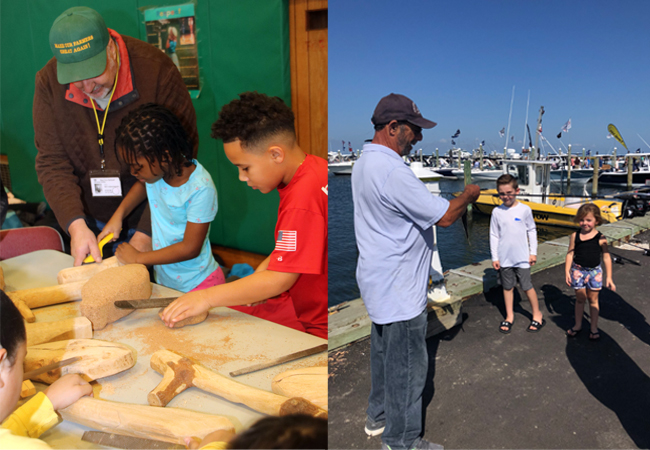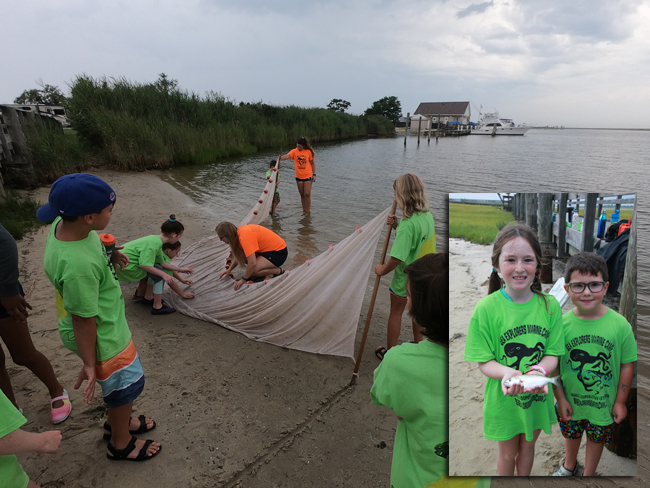
Chris Hale, a master model maker and boat builder, interacts with some students at Weeks Boat Yard in Patchogue. Credit: Nancy Solomon
— By Chris Gonzales, Freelance Science Writer, New York Sea Grant (with additional information by Paul C. Focazio)
Contact:
Antoinette Clemetson, NYSG Marine Fisheries Specialist, P: 631-632-8730, E: aoc5@cornell.edu
Stony Brook, NY, May 5, 2022 - A half dozen recreational fishing projects, each receiving up to $74,000 in support, are benefiting a number of New York communities.
The funds — raised through fees from the Marine and Coastal District license plate — have been provided via a partnership between New York Sea Grant (NYSG), the New York State Department of Environmental Conservation (NYSDEC), and the Marine and Coastal District of New York Conservation, Education, and Research Grants Program. When supporters register their cars with these license plates, which feature the Montauk Lighthouse and a striped bass, they are also pitching in to support marine sport fishing and recreational angling, as well as public awareness and appreciation of marine and coastal natural resources.

Environmental and fishing grant programs are funded collectively with $25 from the annual fee from each Marine and Coastal District license plate. Credit: New York Department of Motor Vehicles
Projects Promote Fishing
In 2019, six year-long projects were funded to promote recreational fishing activities and education. Investigators leading these projects:
• took elementary students on a trip to a salt marsh, where they learned about the striped bass fishery and this prized fish’s ecology, biology, and habitat (see “Operation Salt Marsh Restoration”).
• encouraged student anglers to drop their lines in the East River at the Brooklyn Bridge Park as part of an effort to build a fish database (see "On YouTube: Small Grant Project Supports Fishing Clinic in Brooklyn”).
• built an award-winning ADA-compliant bait station, a place where anglers can cut and clean bait and fish, on the East River Esplanade in East Harlem.
• introduced fourth-grade elementary students to angling, with topics such as using a fishing rod, switching bait, and understanding fishing regulations.
• delivered free public fishing clinics at the East River, where participants learned about sustainable fishing practices.
• enabled students from untapped school districts to enjoy the fun of fishing while taking in marine ecology classes.
Spotlight on Heritage

(At left) Award-winning decoy carver George Rigby helps out some kids with their projects; (At right) Reed Reimer, a master recreational fisherman, teaches students at the Tobay Boat Show how to hold and use a fishing rod. Credit: Nancy Solomon
Long Island Traditions, an organization that runs fishing excursions and teaches about the maritime and recreational fishing history of the area, led approximately 500 students from Freeport, New York, a region hard-hit by October 2012’s Superstorm Sandy, on a fishing tour. The students learned: (a) about the south shore estuary and fishing techniques from a master traditional recreational angler; (b) how to catch fluke and other migratory fish; (c) about the area’s rich maritime heritage, meeting and working with anglers, decoy carvers, boat builders, and other tradition bearers.
“First Hand Fishing has brought together students in untapped school districts and local fishermen, who together have explored the changing ecology of Long Island,” said Nancy Solomon, folklorist and executive director of Long Island Traditions. “Through workshops and field trips the students have learned how the personal experiences of traditional recreational and commercial fishermen have been transformed by warming seas and more frequent storms and hurricanes. Our goal was to shed light on these changing dynamics and how fishermen are often the first witnesses to these changes.”
Spotlight on Stewardship

Campers learn to catch fish with a seine, a weighted net. (Inset) A camper shows off her first fish. Credit: Tracy Marcus
Those leading another project, “Sport Fishing Frenzy,” provided 300 youth from untapped school districts with an educational program all about sport fishing. They made scientific observations related to Long Island’s saltwater ecosystems and talked about the effects human beings have on those systems. The goal was to encourage more young people to be responsible stewards of aquatic resources.
Many students from untapped areas lack experiences of Long Island’s renowned beaches and shorelines, the organizers noted. Their plan was to use the Sport Fishing Education Center in Babylon, NY to introduce young people to the diverse habitats and resources of the area.
“Through participation in our Sport Fishing Frenzy program, with funding from Sea Grant, students participated in an interactive, educational experience that connected them with nature and the great outdoors of Long Island,” said Mary Foglia and Tracy Marcus of Cornell Cooperative Extension of Suffolk County. Foglia is an administrative assistant with the marine program and Marcus serves as director of Sea Explorers Marine Camp.
“Through discussion of recreational fishing techniques and state regulations, exploration of conservation concepts, and fishing practice, we are fostering an appreciation of Long Island’s saltwater ecosystems. Our program provides a natural setting to learn about marine ecology and established a foundation for youth in becoming stewards of aquatic resources and responsible members of the recreational fishing community.”
Award-Winning Design
Grant monies helped build an ADA-compliant bait station for anglers to prepare bait and clean their catch. It's located on the East River Esplanade in East Harlem. Listen to audio from WNYC radio reporter (and fish illustration artist) Clarisa Diaz when she spoke about El Barrio Bait Station on "All Things Considered."
In 2021, another project recipient, the Friends of the East River Esplanade, and its partners (including JACOBSCHANG Architecture, Silman Structural Engineers, Maspeth Welding, SMI Construction Management, Inc. and fish illustration artist Clarisa Diaz) received two awards — the AIA Excelsior Award (for “Public Art”) from the American Institute of Architects of New York State (AIANYS) and the Municipal Art Society (MAS)terworks Award of New York (for “Best New Infrastructure”) — for their design of The East Harlem El Barrio Bait Station.
With support from the local fishermen in the community, the team designed and installed this ADA-accessible station to prepare bait and handle catch at a popular fishing area along the river that was previously without angler amenities.
The structure, constructed of steel and featuring a handicap-accessible cutting surface as well as vibrant illustrations of different fish that can be caught in the East River, serves as a prototype with hope for long term impacts.
“We are looking to extend the station’s lifetime at that spot, and ideally, it would be great if this project was replicated elsewhere on the esplanade,” said Stacy Papas, Executive Director, Friends of the East River Esplanade. “It is such a great amenity for the community and can be a prototype for other places around New York and beyond. This simple project has provided a huge impact. It brings people out of the congested areas to the waterfront and serves as a tool for the fishermen that heavily use the esplanade. The fact that the project has been recognized with these incredible awards helps bring a lot of attention to the sport and the community.”
“The design is utilitarian to serve the needs of the fishermen, but our client, Esplanade Friends, also wanted it to surprise, delight, and educate all who walk by,” said Sari Chang, a principal of the award-winning firm JACOBSCHANG Architecture, who emphasized that despite its small footprint (1 sq ft), the El Barrio Bait Station has a purpose beyond its utility. "Public art can bring attention to important issues that haven’t been noticed or need to change. In this case it symbolizes hope for future revitalization of the East River waterfront. Esplanade Friends recognized that the simple act of building a bait station could illuminate issues of diversity, equity, inclusion, accessibility, and belonging – bringing attention to the Harlem esplanade and the fishing community.”
The awards recognize the positive impact of this project and bring notice to what is possible for places in need of innovative infrastructure, increased functionality, and renewal.
“These awards further emphasize the bait station’s role as public art by bringing more awareness to the vicinity along the East Harlem waterfront where it stands.”
More Info: Marine Small Grants
Funding for these projects is supported from the Marine and Coastal District License Plate, which is administered by the Marine and Coastal District of New York Conservation, Education and Research Board, and authorized through NYS Environmental Conservation Law Article 13, Title 5 Section 13-0503. Any opinions, findings, and conclusions or recommendations expressed in this publication are those of the author(s) and do not necessarily reflect the views of New York State Department of Environmental Conservation, Stony Brook University or New York Sea Grant.
More Info: New York Sea Grant
New York Sea Grant (NYSG), a cooperative program of Cornell University and the State University of New York (SUNY), is one of 34 university-based programs under the National Oceanic and Atmospheric Administration’s National Sea Grant College Program.
Since 1971, NYSG has represented a statewide network of integrated research, education and extension services promoting coastal community economic vitality, environmental sustainability and citizen awareness and understanding about the State’s marine and Great Lakes resources.
Through NYSG’s efforts, the combined talents of university scientists and extension specialists help develop and transfer science-based information to many coastal user groups—businesses and industries, federal, state and local government decision-makers and agency managers, educators, the media and the interested public.
The program maintains Great Lakes offices at Cornell University, University at Buffalo, SUNY Oswego and the Wayne County Cooperative Extension office in Newark. In the State's marine waters, NYSG has offices at Stony Brook University and Cornell Cooperative Extension of Nassau County on Long Island; at Brooklyn College, with New York City Department of Environmental Protection in Queens and at Cornell Cooperative Extension in NYC and Elmsford and Kingston in the Hudson Valley.
For updates on Sea Grant activities: www.nyseagrant.org has RSS, Facebook, Twitter, Instagram, and YouTube links. NYSG offers a free e-list sign up via www.nyseagrant.org/nycoastlines for its flagship publication, NY Coastlines/Currents, which is published quarterly.